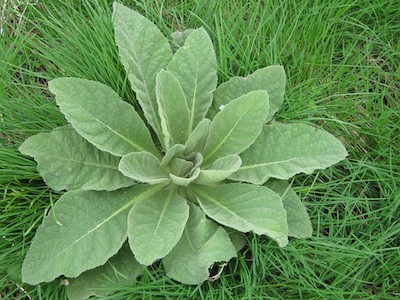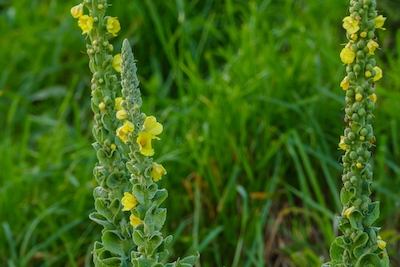 Great mullein is a biennial flowering plant with a long history of use in traditional medicine. Treating painful ear infections is one of the more common mullein uses, but the herb is also used to fight colds and flu, diarrhea, and a variety of inflammatory conditions.
Great mullein is a biennial flowering plant with a long history of use in traditional medicine. Treating painful ear infections is one of the more common mullein uses, but the herb is also used to fight colds and flu, diarrhea, and a variety of inflammatory conditions.
Known scientifically as Verbascum thapsus, great mullein is native to the northern temperate climates of Europe, West Asia, and North Africa. It was later introduced worldwide, including to the Americas and Australia and New Zealand.
The plant’s various, often unusual names speak to its global travels and uses. Some of these include common mullein, woolly mullein, Aaron’s rod, Indian rag weed, beggar’s blanket, and clown’s lungwort.
Great mullein begins its two-year lifespan as a grounded rosette of sizeable leaves. The plant shoots up to two to seven feet high in its second year, with large, downy green leaves at the base of its tall flowering stem.
Clusters of small yellow flowers adorn the flower spike’s highest segment. These bloom between early summer and early fall.
The flowers, leaves, and roots of the plant are used to make medicinal teas, oils, and pastes. Today, we’ll take a look at the many uses of great mullein, as well as its potential health benefits and side effects.
Great Mullein Uses
Great mullein has been used for centuries to treat illness, across cultures and continents.
Dioscorides, the Greek physician and botanist, recommended mullein for lung and breathing disorders more than 2,000 years ago. In fact, in North America, Native American tribes reportedly inhaled smoke from the burning leaves to help clear congested lungs. Others also smoked a blend of mullein leaf and nicotine leaf to treat asthma.
The Nahuatl of Mexico called the herb gordolobo, and it is still used today by local herbalists to alleviate throat problems, varicose veins, and hemorrhoids.
Meanwhile, in Ireland, citizens traditionally relied on the herb as a tuberculosis remedy. Daily consumption of the leaves boiled in milk helped nurse the bacterial lung infection.
Boiled mullein leaves were also the base for a warm paste that soothed coughs in addition to irritated or infected skin.
Other uses for great mullein include treating:
- Earaches
- Bronchitis
- Pneumonia
- Gout and other joint pain
- Migraines
- Burns and wounds
- Eczema
- Herpes viruses
Although different civilizations have created many unique mullein remedies, two of the most well-known may be mullein tea and mullein oil.
Mullein Tea
Mullein tea is brewed using the plant’s fresh or dried leaves and flowers. You can also purchase prepackaged mullein tea bags. Steeping the loose leaves or bags in hot water is thought to release mullein’s beneficial nutrients and properties.
Proponents generally consume one cup of tea up to four times daily for respiratory ailments.
Mullein Oil
 Mullein oil is extracted from V. thapsus flowers and leaves. It can be made using two methods: cold oil infusion or hot oil infusion.
Mullein oil is extracted from V. thapsus flowers and leaves. It can be made using two methods: cold oil infusion or hot oil infusion.
Cold infusion entails soaking fresh or dried mullein flowers and/or leaves in room temperature olive oil, or another carrier oil of your choice, for seven to 10 days. The oil is then strained with a cheesecloth and transferred to a dark glass bottle for storage.
The hot infusion method involves heating the flowers or leaves in a carrier oil over low heat for several hours.
The oil serves as an all-natural ear drop solution for painful earaches. It’s additionally applied to the skin for conditions such as eczema.
Potential Great Mullein Benefits
Great mullein has enjoyed widespread use as a folk and traditional remedy, but is there scientific evidence to support the claims of healing benefits?
Research has found that mullein species contain several bioactive compounds, which may contribute to the plants’ medicinal effects. These include flavonoids, saponins, iridoids, and glycosides.
Each of these plant chemicals exhibits anti-inflammatory activity, while flavonoids and glycosides also act as antioxidants.
Great mullein has mucilage as well. This thick, sticky substance swells in water, creating a gelatinous material that may soothe irritated mucous membranes.
Let’s explore these potential mullein benefits in greater detail.
May Soothe Respiratory Ailments
The mucilage in great mullein may be especially useful for respiratory conditions.
It’s thought to be responsible for the herb’s demulcent properties—that is, its ability to soothe and protect inflamed or irritated tissue. This can include portions of the respiratory tract, such as the nasal passages, throat, bronchial tubes, and lungs.
Mullein may also function as an expectorant. Expectorants help the body expel mucus from airways.
Asthma is characterized by excess mucus production in the bronchial tubes as well as their constriction or narrowing. Mullein’s expectorant, anti-inflammatory, and antispasmodic qualities may help to relax the muscles and open the tubes during asthma attacks.
Research in animals and lab settings has further shown that mullein can help relax muscles of the intestinal tract.
The demulcent and expectorant activities can also benefit issues like bronchitis, chronic obstructive pulmonary disease (COPD), dry cough, and sore throat.
There are no high-quality human studies confirming mullein’s ability to treat these conditions, however.
May Relieve Ear Infections
Great mullein is used topically as an emollient to soften and moisturize dry, cracked skin. As an astringent, it may decrease the risk of bacterial or fungal infections by keeping skin dry.
Both these functions could aid in relief from ear infections.
Mullein oil is often used alone or with other antibacterial herbs as an ear infection remedy, particularly for pain relief. In a study published in the Archives of Pediatrics and Adolescent Medicine in 2001, a mullein tincture containing garlic and St. John’s wort worked as well as a prescription anesthetic ear drop in children.
For now, research in this area is only preliminary. Further study will decide whether mullein oil can be suggested as an effective treatment or preventive tool for ear infections.
May Have Antiparasitic, Antiviral, and Antibacterial Effects
Research suggests great mullein could have powerful effects against parasitic and microbial infections.
Antiparasitic
In one lab study, published in the journal BMC Complementary and Alternative Medicine in 2012, great mullein showed antiparasitic activity against roundworms and tapeworms. A V. thapsus extract produced paralysis and death in both species of test worms.
At high concentrations, the extract was even more effective than albendazole, a wormicidal drug, against the tapeworms.
Antiviral
Other test-tube studies demonstrate mullein’s antiviral potential.
One 2009 study assessing the antiviral effects of 41 plant species found that great mullein extract showed markedly strong activity against the influenza virus.
And the results of a 2012 lab study suggest the herb may also combat the pseudorabies virus—an animal strain of herpes virus. The findings mirrored earlier research published in the journal Revista Latinoamericana de Microbiologia, where V. thapsus also blocked pseudorabies infectivity.
Antibacterial
Yet more research reveals the bacteria-fighting abilities of great mullein in vitro.
In a 2020 study, the plant extract suppressed multiple gram-positive bacterial strains but showed the most strength against Bacillus cereus. This foodborne bacterium causes gastrointestinal illness, with symptoms like diarrhea and vomiting.
Researchers also recorded the extract’s antioxidant activity, noting that concentrations of 300 milligrams per liter resulted in 91.31% inhibition of free radicals.
Another in vitro study out of Clemson University concluded that great mullein extract was effective against gram-negative strains such as Klebsiella pneumonia and Escherichia coli. It also showed antibacterial activity against gram-positive Staphylococcus aureus and Staphylococcus epidermidis.
It is important to remember that while great mullein has shown great promise in the above studies and anecdotally, much of the research is in its beginning stages. There’s a need for larger clinical trials before it can be officially recommended for medical use.
Great Mullein Side Effects and Risks
Great mullein is generally considered safe for short-term use in most populations. The existing research has not shown any serious side effects.
However, there is the risk of an allergic response, including skin reactions like contact dermatitis. As such, those who are especially sensitive should use caution on first use. Perform a skin-patch test or consume only a small amount of the tea to check for adverse reactions.
The hairs of the plant may also cause discomfort for some, so be sure to filter them out when making the tea or oil.
Since studies on mullein’s safety in pregnant and breastfeeding women and young children are unavailable, these groups should avoid using the herb.
Finally, great mullein has been reported to increase the effects of lithium and muscle relaxants.
It may also reduce the efficacy of antidiabetic drugs. Furthermore, as mullein acts as a natural diuretic, it may cause excess potassium excretion in those on prescription diuretics.
You should always consult your doctor or pharmacist before using any herbal remedy, but it is especially important if you are currently taking any of these medications.
Article Sources (+)
Karman, R. “Assessing the Effectiveness of Mullein on Respiratory Conditions Such as Asthma,” 2016; https://www.researchgate.net/publication/308991417_Assessing_the_Effectiveness_of_Mullein_on_Respiratory_Conditions_Such_as_Asthma.
Ali, N., et al., “Anthelmintic and relaxant activities of Verbascum Thapsus Mullein,” BMC Complementary and Alternative Medicine, 2012;12:29;
https://www.ncbi.nlm.nih.gov/pmc/articles/PMC3350428/.
Rajbhandari, M., et al., “Antiviral activity of some plants used in Nepalese traditional medicine,” Evidence-Based Complementary and Alternative Medicine, 2009;6(4):517-522; https://www.ncbi.nlm.nih.gov/pmc/articles/PMC2781767/.
Escobar, F.M., et al., “Antiviral effect and mode of action of methanolic extract of Verbascum thapsus L. on pseudorabies virus (strain RC/79),” Natural Product Research, 2012; 26(17):1621-5; https://pubmed.ncbi.nlm.nih.gov/21999656/.
Zanon, S.M., et al., “Search for antiviral activity of certain medicinal plants from Córdoba, Argentina,” Revista Latinoamericana de Microbiologia, Apr. to June 1999; 41(2):59-62; https://pubmed.ncbi.nlm.nih.gov/10932751/.
Mahdavi, S., et al., “The Antioxidant, Anticarcinogenic and Antimicrobial Properties of Verbascum thapsus L,” Medicinal Chemistry, 2020; 16(7):991-995; https://pubmed.ncbi.nlm.nih.gov/31456524/.
Turker, A.U. and Camper, N.D., “Biological activity of common mullein, a medicinal plant,” Journal of Ethnopharmacology, Oct. 2002; 82(2-3):117-125; https://pubmed.ncbi.nlm.nih.gov/12241986/.
Ghoshal, M., “Mulling Over Mullein Leaf,” Healthline, March 13, 2020; https://www.healthline.com/health/mullein-leaf.
Price, A., “Mullein: The Herb that Fights Infections and Inflammation,” Dr. Axe, January 31, 2020; https://draxe.com/nutrition/mullein/.
“Health Benefits of Mullein Tea,” WebMD; https://www.webmd.com/diet/health-benefits-mullein-tea, last accessed November 30, 2021.
Hanrahan, C. and Frey, R., “Mullein,” The Gale Encyclopedia of Alternative Medicine; https://www.encyclopedia.com/plants-and-animals/plants/plants/mullein, last accessed November 30, 2021.
“MULLEIN,” RxList; https://www.rxlist.com/mullein/supplements.htm, last accessed November 30, 2021.
Link, R., “What Is Mullein Tea? Benefits, Side Effects, and More,” Healthline, October 23, 2019; https://www.healthline.com/nutrition/mullein-tea.
